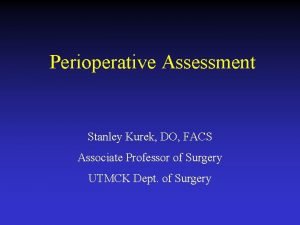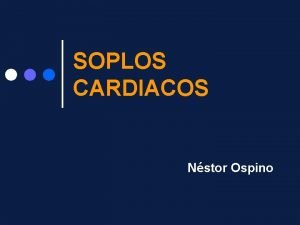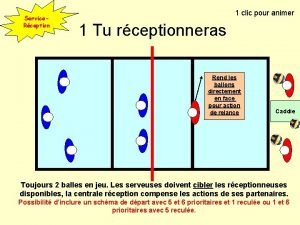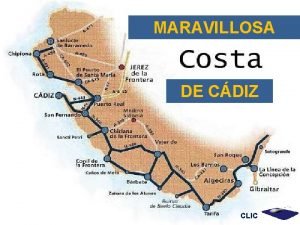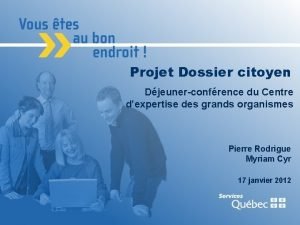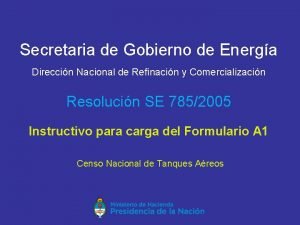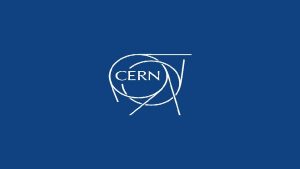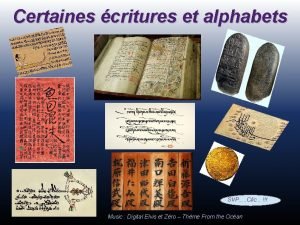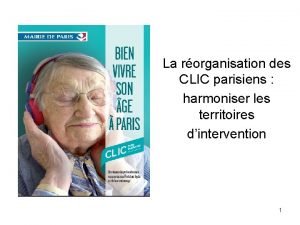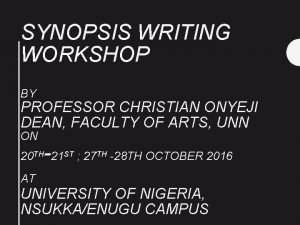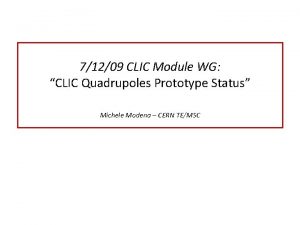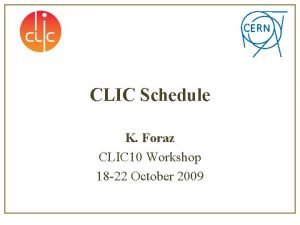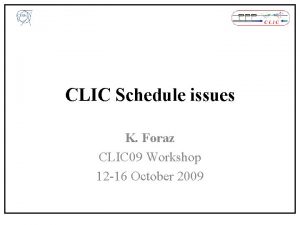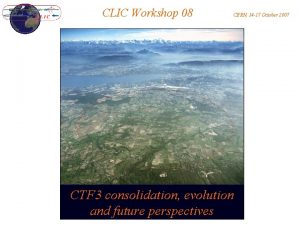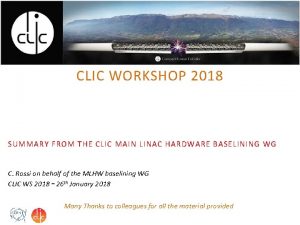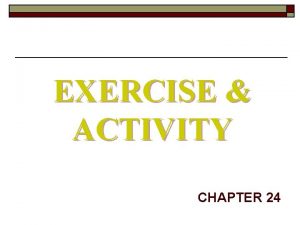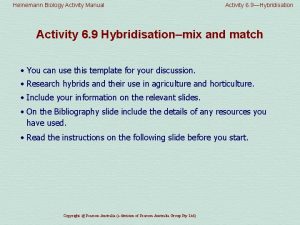CLIC 09 Workshop STATUS OF CLIC ACTIVITY AT























- Slides: 23

CLIC’ 09 Workshop STATUS OF CLIC ACTIVITY AT IAP A. K. Kaminsky, S. V. Kuzikov*, A. A. Perelstein, S. N. Sedykh Joint Institute for Nuclear Research, Dubna, Russia *Institute of Applied Physics, Nizhny Novgorod, Russia *Gycom Ltd. , Nizhny Novgorod, Russia Outline 1. 2. 3. 4. 5. Scope of activities 12 GHz BMC IAP – JINR pulse heating experiments at 30 GHz multi-megawatt gyrotron and gyroklystron Studies of multipactor discharges 1. Methods to suppress multipactor on dielectric surface (windows and dielectric based accelerating structures) 1. Multipactor on metallic surface (RF switches) 6. Future plans and prospects

CLIC’ 09 Workshop Contracts with Gycom Ltd. : 1. 30 GHz transmission line and RF components 2. 30 GHz SLED II PC 3. Length compensators for transmission lines 4. Pumping ports at big waveguide diameter 5. Vacuum valve 6. Attenuators and phase shifters at 30 GHz and 12 GHz 7. 12 GHz BMC 12 GHz attenuator Total: 10 contracts for last 3 years 12 GHz phase shifter

CLIC’ 09 Workshop 12 GHz BMC (under construction) Scheme of BMC (beet mode pulse compressor).

CLIC’ 09 Workshop TE 01 – TE 01+TE 02 beeting mode converter Reflected and transmitted modes Simulation of the BMC with coupling iris TE 01 and TE 02 phases

CLIC’ 09 Workshop All necessary parts have been produced. We wait for the second stepping motor. Low power tests are scheduled on October - November 2009.

Pulse heating experiments CLIC’ 09 Workshop Electron beam 0. 8 Me. V / 200 A / 250 ns Bragg cavity with step of corrugation phase output waveguide, based on Talbot effect solenoid (B 0 ~ - 0. 2 Т) Helical undulator (dw = 6 cm, Bw ~ 0. 1 Т) Focusing lenses Scheme of the 30 GHz FEM based on accelerator LIU-3000

CLIC’ 09 Workshop Experimental results 100 нс Heterodyne signal RF-spectrum ВЧ-импульс f = 30. 05 GHz Df ~ 6 - 10 MHz PRF = 20 MW (30 MW) τRF = 200 ns (100 ns) η = ~ 20% (25%) 50 MHz WRF ~ 3 - 4 J Rep. rate 0. 5 - 1 Hz

CLIC’ 09 Workshop Experimental investigations of copper degradation effects caused by RF pulsed heating by means of 30 GHz FEM Output section of FEM Confocal mirror line Directional coupler to control incident and reflected radiation RF detector Test cavity Mode converters: Gaussian wavebeam – TE 1, 1 wave – TE 0, 1 wave

CLIC’ 09 Workshop Test cavity Magnetic field Photograph of the unexposed surface

CLIC’ 09 Workshop Photographs of the exposed surface (250 C, 6 104 RF pulses)

CLIC’ 09 Workshop Breakdown marks The carried out experiments on pulse heating at 30 GHz show that temperature rise 50 C per pulse does not spoil cavity surface (N<105). Temperature rise 200 -250 C leads to dramatic degradation of the tested copper surface and causes very frequent breakdown (BDR=0. 3 -0. 5) if total number of RF pulses reaches 6∙ 104.

30 GHz gyrotron/gyroklystron U=300 -450 к. V, I=180 А, =0. 5 -1. 5 s, frep=1 -10 Hz, F=30 GHz RF power = 10 -15 MW. CLIC’ 09 Workshop

CLIC’ 09 Workshop IAP experiments with multipactor discharge in X – band Experimental setup TE 012 1 - magnetron, 2 - directional coupler, 3 - circulator, 4 - mode converter, 5 - circular waveguide, 6 microwave window, 7 - diaphragm, 8 - studied dielectric disk, 9 - high voltage input, 10 - insulator, 11 - electrode (back wall of the resonator), 12 observation window, 13 and 14 - disk and electrode transfer mechanisms, respectively, 15 - pressure gauge, 16 - mechanical pump, 17 - ion pump, 18 high-voltage source, 19 - microwave detector, 20 oscilloscope 1 – amplitude of the RF field for an incident power 100 k. W 2 – quartz disk Distribution of the microwave electric field in the resonator

CLIC’ 09 Workshop Distribution of the microwave electric field Dependence threshold value of pondermotive force [1] - M. A. Lobaev, O. A. Ivanov, V. A. Isaev, А. L. Vikharev, Tech. Phys. Lett. v. 35, N 12. [2] - O. A. Ivanov, M. A. Lobaev, V. A. Isaev, А. L. Vikharev, Physical Revue ST AB (in press)

CLIC’ 09 Workshop Influence of external DC bias Ef=0 Distribution of the electrostatic field Dependence of the multipactor threshold on the amplitude of the electrostatic field 1. The experiments performed showed that one can effectively suppress the multipactor dicharge on a dielectric. 2. The effects make it possible to use such an undesirable phenomenon as a multipactor for practical purposes, e. g. , in high-power microwave switches intended to modulate the Q-factor in active compressors of microwave pulses.

CLIC’ 09 Workshop Raise of multipactor threshold by means of external DC bias Mode converters RF Cathode Beet mode RF U Isolators Cathode U RF structure Anode Dielectric window Anode High-power window Dielectric slabs Dielectric accelerating structure

CLIC’ 09 Workshop Multipactor at metallic surface with external static magnetic field λ = 3. 3 cm, diameter of the waveguide ring is near 100 mm 8 10 GHz 200 k. W magnetron 1 – vacuum casing; 2 - RF window; 3 – input and output waveguide flange; 4 – openings for waveguide evacuation; 5 – heater; 6 – pulse solenoid; 7 – waveguide bended into a ring; 8 – magnetic field profile

CLIC’ 09 Workshop Tested waveguide

CLIC’ 09 Workshop Transmitted RF power at the absence and presence of multipactor discharge Traces of output power at the absence (1) and the presence (2) of multipactor discharge. The input power is 44 k. W (a) and 220 k. W (b) U – voltage pulse

CLIC’ 09 Workshop Dependence of the absorbed RF power on the static magnetic field 8 Magnetic field can be used for slow ( 1 s) RF switching Multipactor absorption in the input and output waveguides near the brink of solenoid

CLIC’ 09 Workshop Fast active RF switch (phase shifter) based on induced multipactor 30 GHz RF (TE 01 mode) High-Q 30 GHz cavity (operating RF) 10 GHz RF (TEM mode) The same cavity at 10 GHz, low-Q (switching RF) 10 GHz radiation of k. W power level initiates multipactor, 30 GHz operating radiation of multi-megawatt power level is scattered and absorbed by the prepared multipactor. Swiching time is 10 -20 ns.

CLIC’ 09 Workshop r. L Multipactor layer Simulation of multipactor influence r. L – is Larmour radius. Phase switching by multipactor Solid curve is the phase before multipactor, Dashed curve is the phase under multipactor.

CLIC’ 09 Workshop Conclusion We will do the best in order to complete all day-to-day contracts, to solve all technical problems, and hope to continue collaboration with CLIC.
 Dipyramadole
Dipyramadole Soplo mesosistolico aortico
Soplo mesosistolico aortico Au clair de la lune grand saint nicolas
Au clair de la lune grand saint nicolas Cern clic
Cern clic 1 clic reception
1 clic reception Clic
Clic What does dead clic stand for
What does dead clic stand for Clic sécure citoyen
Clic sécure citoyen Web res. 1102-404 y res. 785
Web res. 1102-404 y res. 785 Imagenes de clic
Imagenes de clic Palabras con v
Palabras con v Rey orozco
Rey orozco Protocananéen
Protocananéen Clic paris emeraude
Clic paris emeraude Clic
Clic How to compute net of vat
How to compute net of vat Activity 1 activity 2
Activity 1 activity 2 Activity and activity coefficient
Activity and activity coefficient Activity 1 activity 2
Activity 1 activity 2 Aoa diagram example
Aoa diagram example 1index
1index Form content and use
Form content and use Activity 2 limiting reactants activity
Activity 2 limiting reactants activity Workshop synopsis examples
Workshop synopsis examples
